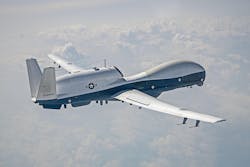Navy orders amplifier chassis from Argon ST for signals intelligence (SIGINT) Triton unmanned aircraft
PHILADELPHIA – U.S. Navy unmanned aerial vehicle (UAV) experts needed amplifier chassis to support the MQ-4C Triton maritime patrol UAV with the first deployment of IFC 4.0-configured unmanned aircraft. They found their solution from Argon ST, a Boeing company in Fairfax, Va.
Officials of the Naval Supply Systems Command Weapon Systems Support activity in Philadelphia has announced a $21 million order to Argon ST for nine amplifier chassis in support of IFC 4.0-configured Triton UAVs.
The MQ-4C Triton is a maritime patrol version of the Northrop Grumman RQ-4 Global Hawk long-range reconnaissance UAV. The Triton provides real-time intelligence, surveillance, and reconnaissance missions (ISR) over vast ocean and coastal regions.
Related: Northrop Grumman prepares for SIGINT upgrades to the MQ-4C Triton maritime patrol UAV
The unmanned aircraft is designed to perform continuous maritime surveillance, conduct search and rescue missions, and to complement the Boeing P-8 Poseidon crewed maritime patrol aircraft.
The Integrated Functional Capability (IFC) 4.0 version offers signals intelligence (SIGINT) capability to match that of the Navy's EP-3 manned SIGINT aircraft, which the IFC 4.0 version of the Triton is replacing. The IFC-4 upgrade includes the Minotaur mission system used on the EP-3E.
The Triton program is installing a SIGINT sensor payload with components from Boeing Argon ST in Fairfax, Va., and Sierra Nevada Corp. in Sparks, Nev.
Later upgrades of the IFC 4.0 Triton are expected to involve artificial intelligence (AI) and machine learning; wideband tactical targeting network technology, enhanced radar identification modes; protected satellite communications; M-Code satellite navigation; and counter-electronic attack.
As the IFC-4 configuration is deployed, experts will modify the UAV's mission control centers with special compartmented intelligence facilities to protect sensitive intelligence gathering and dissemination.
On this order, Argon ST will do the work in Fairfax, Va., and should be finished by March 2025. For more information contact Argon ST online at www.argonst.com, or the Naval Supply Systems Command Weapon Systems Support activity-Philadelphia at www.navsup.navy.mil/NAVSUP-Enterprise/NAVSUP-Weapon-Systems-Support/About-NAVSUP-WSS.
About the Author
John Keller
Editor-in-Chief
John Keller is the Editor-in-Chief, Military & Aerospace Electronics Magazine--provides extensive coverage and analysis of enabling electronics and optoelectronic technologies in military, space and commercial aviation applications. John has been a member of the Military & Aerospace Electronics staff since 1989 and chief editor since 1995.
